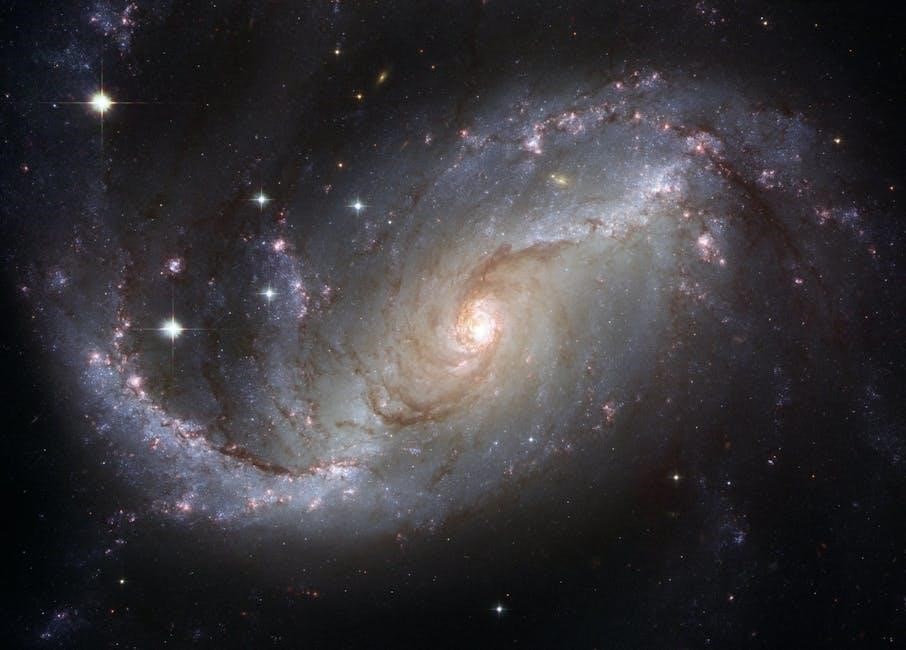Embark on an enthralling voyage through the cosmos! This section offers a comprehensive introduction to the universe, its vastness, and the fundamental principles that govern its existence.
Welcome to an introductory exploration of the universe, a journey that transcends everyday living and delves into the extraordinary. Whether you’re a child or an octogenarian, this guide offers a gentle foray into the cosmos, unraveling its mysteries one step at a time. We begin with the basics, venturing beyond our solar system, past the Milky Way, to the farthest reaches of space. Consider this your personal invitation to embrace the universe’s wonders.
This guide thoughtfully leads you through a range of topics, from fundamental relationships to the responsibilities we share and the adversities we face, illuminating the path to understanding our place within this vast cosmic tapestry. It’s more than just a book; it’s an experience, a journey of discovery that will leave you in awe of the universe’s beauty and complexity.

Cosmology for Beginners
Cosmology 101 awaits! This section simplifies the complex science of cosmology, making it accessible to everyone. Explore the universe’s origins, evolution, and ultimate fate in an easy-to-understand format.
Expansion of the Universe
Delve into one of the most groundbreaking discoveries in cosmology: the expansion of the universe! Discovered by Edwin Hubble, this phenomenon reveals that galaxies are moving away from each other, indicating a universe that is constantly growing.
Explore the evidence supporting this expansion, including redshift measurements and observations of distant supernovae. Understand Hubble’s Law, which quantifies the relationship between a galaxy’s distance and its recession velocity.
Examine the role of dark energy, a mysterious force believed to be driving the accelerated expansion of the universe. Discuss the implications of this expansion for the past, present, and future of the cosmos. Learn about the Big Bang theory, the prevailing cosmological model that explains the origin and evolution of the universe from an extremely hot, dense state.
Consider the concept of the observable universe and the limitations imposed by the finite speed of light. Explore alternative theories and ongoing research aimed at unraveling the mysteries of cosmic expansion.
Cosmic Microwave Background (CMB)
Uncover the secrets of the Cosmic Microwave Background (CMB), the afterglow of the Big Bang! This faint radiation permeates the universe, providing a snapshot of the cosmos when it was only about 380,000 years old.
Discover how the CMB was formed as the universe cooled and neutral atoms began to form, allowing photons to travel freely. Explore the significance of the CMB’s temperature fluctuations, which reveal the seeds of structure formation in the early universe.

Learn about the experiments and missions, such as COBE, WMAP, and Planck, that have mapped the CMB with increasing precision. Understand how the CMB provides crucial evidence supporting the Big Bang theory and our understanding of the universe’s composition and evolution.
Discuss the information encoded in the CMB about the universe’s age, geometry, and matter content. Explore how the CMB is used to test cosmological models and constrain the properties of dark matter and dark energy. Consider the ongoing research aimed at further unraveling the mysteries of the CMB and its implications for our understanding of the universe.

Exploring the Universe
Delve into the methods and instruments used to explore the vast universe! From ground-based observatories to space telescopes, discover how we gather data about celestial objects.
Telescopes and Observatories
Telescopes are our eyes on the universe, enabling us to observe distant stars, galaxies, and other celestial phenomena. Ground-based observatories, often located in remote, high-altitude locations with dark skies, minimize atmospheric interference.
These telescopes use lenses or mirrors to collect and focus light, allowing astronomers to study the properties of cosmic objects. Radio telescopes, on the other hand, detect radio waves emitted by celestial sources, providing a different perspective on the universe.
Space-based telescopes, such as the Hubble Space Telescope, offer unobstructed views from above the Earth’s atmosphere. They provide unparalleled clarity and access to a wider range of electromagnetic radiation, including ultraviolet and infrared light.
Observatories, housing multiple telescopes and advanced instruments, serve as hubs for astronomical research. They facilitate collaboration among scientists and enable comprehensive studies of the cosmos. The data collected from these observatories expands our knowledge.
James Webb Space Telescope Discoveries
The James Webb Space Telescope (JWST) is revolutionizing our understanding of the universe. Its advanced infrared capabilities allow it to peer through cosmic dust clouds, revealing previously hidden stars and galaxies. JWST is transforming what we see.
One of the key discoveries of JWST is the identification of some of the earliest galaxies ever formed. These galaxies, dating back to the dawn of the universe, provide insights into the conditions that prevailed shortly after the Big Bang.
JWST is also making significant contributions to exoplanet research. By analyzing the light passing through the atmospheres of distant planets, scientists can determine their composition and search for signs of habitability. What an amazing instrument!
Furthermore, JWST is providing unprecedented views of star formation regions. Its observations are helping us understand how stars are born and how planetary systems form around them. The clarity and precision that it offers is unparalleled.

Astrobiology Basics
Explore the fascinating field of astrobiology! This section introduces the search for life beyond Earth, examining the conditions necessary for life and the potential for extraterrestrial existence.
Astrobiology, also known as exobiology, represents an interdisciplinary scientific field dedicated to investigating the possibility of life beyond Earth. It seeks to understand the origin, evolution, distribution, and future of life in the universe. This exciting area combines aspects of astronomy, biology, chemistry, geology, and physics.
The study of astrobiology delves into defining what constitutes life, exploring extreme environments on Earth that might offer analogs for extraterrestrial habitats. Scientists explore questions about the emergence of life, its adaptability to diverse conditions, and its potential to exist in various forms throughout the vast cosmos. It considers the roles of water, carbon, and energy in the formation and sustainability of living systems.
Furthermore, astrobiology examines planetary habitability, analyzing the characteristics of planets and moons that could potentially support life. This includes assessing factors such as atmospheric composition, surface temperature, and the presence of liquid water. The search for biosignatures, or indicators of life, is a key focus. These biosignatures could range from specific atmospheric gases to unique geological formations. Astrobiology ultimately seeks to address one of humanity’s most profound questions: Are we alone in the universe?

Navigating the Cosmos
Unlocking the secrets of the universe necessitates understanding light and various waves in astronomy. Explore how these tools unveil celestial wonders, guiding our cosmic understanding.
Understanding Light in Astronomy
Light, a fundamental aspect of the universe, serves as astronomy’s primary messenger, carrying invaluable data from distant celestial objects. By dissecting light, astronomers glean insights into the universe’s composition, temperature, and motion.
Spectroscopy, a crucial technique, involves analyzing the spectrum of light emitted by stars and galaxies. This reveals the elements present within those objects, much like a fingerprint identifies an individual. The Doppler effect, applied to light, unveils whether a celestial body is approaching or receding from us, akin to the changing pitch of a siren.
Different wavelengths of light offer unique perspectives. Visible light allows us to see planets and stars, infrared light penetrates dust clouds, and X-rays expose energetic phenomena. Understanding light’s behavior is paramount in deciphering the cosmos’ mysteries, enhancing our comprehension of its evolution and structure, and helping us explore the universe!
Radio Waves in Astronomy
Radio waves, a form of electromagnetic radiation, provide a unique window into the universe, penetrating cosmic dust and revealing phenomena invisible to optical telescopes. Radio astronomy explores celestial objects emitting radio waves, such as pulsars, quasars, and molecular clouds, offering insights into their composition, structure, and behavior.
Radio telescopes, often vast arrays of antennas, capture these faint signals, allowing astronomers to study the universe’s hidden aspects. Radio waves can penetrate the vast clouds of dust and gas that obscure our view in visible light, allowing us to see the center of our galaxy and other regions that would otherwise be hidden.
By studying radio waves, we can learn about the magnetic fields of planets, the distribution of dark matter, and the formation of stars and galaxies. Radio astronomy is a powerful tool for exploring the universe!
Infrared Astronomy
Infrared astronomy observes celestial objects emitting infrared radiation, a type of electromagnetic radiation with wavelengths longer than visible light. This allows astronomers to study cooler objects in space, such as forming stars, planets, and distant galaxies obscured by dust. Infrared light penetrates cosmic dust clouds, unveiling regions hidden from optical telescopes, revealing the secrets of star formation and galactic evolution.
Infrared telescopes, both ground-based and space-based, capture this radiation, enabling astronomers to analyze the temperature, composition, and motion of celestial objects. Space-based infrared telescopes avoid atmospheric interference, providing clearer images. By studying infrared light, we can explore the universe’s hidden thermal processes.
From mapping the distribution of interstellar dust to identifying exoplanets, infrared astronomy provides a unique perspective on the cosmos. Infrared astronomy is a crucial tool for understanding the universe!
Optical Astronomy
Optical astronomy, the oldest form of astronomical observation, utilizes visible light to study celestial objects. Telescopes, equipped with lenses or mirrors, gather and focus light, creating magnified images of stars, planets, galaxies, and nebulae. These images, captured by cameras or other detectors, reveal the objects’ brightness, color, and structure.
Optical astronomy provides fundamental information about the universe. By analyzing the spectra of light, astronomers can determine the composition, temperature, and velocity of stars and galaxies. Optical telescopes, located on Earth or in space, offer unparalleled views of the cosmos. Observatories carefully selected for their dark skies and stable atmospheric conditions, provide optimal viewing.
Optical astronomy continues to play a vital role in understanding the universe. From discovering new planets to mapping the distribution of galaxies, optical observations provide essential data for advancing astronomical knowledge. It remains an indispensable tool for exploring the universe.

Key Concepts in Cosmology
Delve into the fundamental concepts shaping our understanding of the universe. Explore galaxies, the vast islands of stars, and solar systems, where planets orbit stars.
Galaxies
Galaxies, majestic cosmic islands, are vast collections of stars, gas, dust, and dark matter, bound together by gravity. These sprawling structures come in various shapes and sizes, from the elegant spirals like our own Milky Way to the elliptical behemoths and irregular forms born from cosmic collisions.
Understanding galaxies is crucial to unraveling the universe’s history. They serve as cosmic lighthouses, illuminating the distribution of matter on the largest scales. By studying their composition, structure, and evolution, astronomers piece together the story of how the universe evolved from its earliest moments to its present state.

Within galaxies, stars are born in stellar nurseries, regions of dense gas and dust where gravity collapses matter, igniting nuclear fusion. These stars then shine for billions of years, enriching the galaxy with heavier elements forged in their cores. When stars die, they return their processed material to the interstellar medium, the gas and dust between stars, seeding future generations of stars and planets.
Galaxies also host supermassive black holes at their centers, gravitational monsters that can influence the evolution of the entire galaxy. These black holes can accrete matter, unleashing tremendous energy in the form of jets and radiation, shaping the galaxy’s environment.
Solar Systems
Solar systems, the planetary neighborhoods of the universe, are gravitationally bound systems of a star and the objects that orbit it. Our solar system, with the Sun at its center, is home to eight planets, numerous moons, asteroids, comets, and dwarf planets, each with its own unique characteristics.
These planetary systems form from the protoplanetary disks, swirling clouds of gas and dust that surround young stars. Within these disks, gravity and collisions cause dust grains to clump together, gradually growing into larger and larger objects, eventually forming planetesimals and then planets.
The architecture of a solar system is influenced by various factors, including the mass and composition of the protoplanetary disk, the presence of other stars in the vicinity, and the gravitational interactions between the planets. These factors can lead to a wide diversity of planetary systems, with some hosting hot Jupiters, gas giants orbiting extremely close to their stars, while others may have multiple Earth-sized planets in the habitable zone, the region where liquid water can exist on the surface.
Studying other solar systems helps us understand the conditions necessary for planet formation and the potential for life beyond Earth. The search for exoplanets, planets orbiting other stars, has revealed a vast array of planetary systems, challenging our understanding of how solar systems form and evolve.

Resources for Beginners
Delve deeper into the cosmos with these curated resources. Find beginner-friendly books and online courses designed to ignite your passion for the universe and expand your astronomical knowledge.
Books for Beginners
Embark on your cosmic journey with these carefully selected books, perfect for those just beginning to explore the wonders of the universe. “Introducing the Universe,” a graphic study guide, offers a visually engaging introduction to cosmology, making complex concepts accessible to all. For a gentle and joyful exploration of the universe’s wonders, consider “A Beginner’s Guide to the Universe,” praised for its endearing affection and beautiful wisdom.
Eric Chaisson and Steve McMillan’s “Astronomy: A Beginner’s Guide to the Universe” provides a comprehensive overview of our galaxy and beyond. If astrobiology sparks your interest, seek out introductory texts that offer a breezy and informative look at the possibility of life beyond Earth.
These books cater to readers of all ages, from children to adults, offering a gentle and accessible entry point into the fascinating world of astronomy and cosmology. Prepare to have your mind expanded and your curiosity ignited!
Online Courses
Deepen your understanding of the universe from the comfort of your own home with these engaging online courses. Consider exploring introductory cosmology courses like “Cosmology 101,” which breaks down complex topics such as the expansion of the universe and the cosmic microwave background (CMB) into easily digestible segments. UC Berkeley offers a “Beginner’s Guide to the Universe” course, designed to introduce fundamental concepts.
These online courses offer structured learning paths, interactive exercises, and expert instruction, making them ideal for both beginners and those seeking to expand their knowledge. Topics covered may include the formation of galaxies, the lifecycle of stars, the search for exoplanets, and the latest discoveries from telescopes like the James Webb Space Telescope.
Whether you’re interested in astrobiology, astrophysics, or cosmology, you’ll find an online course to ignite your passion and guide you on your cosmic journey. Don’t miss the chance to explore the universe from your computer!

The Future of Universe Exploration
The future of universe exploration is bright, filled with ongoing research and groundbreaking discoveries. New technologies and missions promise to reveal even more secrets of the cosmos.
Ongoing Research
Cosmology continues to evolve with ongoing research pushing the boundaries of our understanding. Scientists are actively working on several key areas that promise to revolutionize our knowledge of the universe. One major area is dark matter and dark energy, which make up the majority of the universe’s mass-energy density, yet remain mysterious. Researchers are employing various techniques, including gravitational lensing and large-scale structure surveys, to map the distribution of dark matter and constrain its properties.
Another active area is the study of the early universe, particularly the inflationary epoch. Scientists are searching for evidence of primordial gravitational waves in the cosmic microwave background (CMB), which could provide direct insights into the conditions during inflation. Furthermore, studies of galaxy formation and evolution are crucial for understanding how the universe evolved from its initial state to the complex structures we observe today. Simulations and observations are combined to unravel the processes that drive galaxy mergers, star formation, and the growth of supermassive black holes.
These diverse research efforts are paving the way for a deeper comprehension of the universe’s origins, evolution, and ultimate fate.



Leave a Reply
You must be logged in to post a comment.